Many protozoa live in the human body. Many of them are pathogenic. Our story is about ten of them, the majority. The review is compiled from historical and more recent publications.
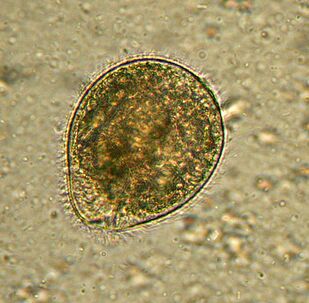
Greater. BalantidiumBalantidium coli
The largest protozoan is a human parasite and the only ciliate of this company. Its dimensions range from 30 to 150 microns in length and from 25 to 120 microns in width. For comparison: the length of the malaria plasmodium in the major stage is about 15 microns, and several times shorter than the balantide of the intestinal cells, among which the ciliate lives. An elephant in a china shop.
Distributedwherever there are pigs - their main carriers. It usually lives in the submucosa of the colon, although in humans it also occurs in the pulmonary epithelium. It feeds onB. colibacteria, food particles, fragments of the host's epithelium. In animals, the infection is asymptomatic. People can develop severe diarrhea with bloody, viscous discharge (balantidiasis), sometimes forming ulcers on the walls of the colon. It is rare to die of balantidiasis, but it causes chronic exhaustion.
People are infected with dirty water or food that contains cysts. The rate of infection in humans does not exceed 1%, while pigs can be infected worldwide.
Treatedwith antibiotics, there are still no reports of drug resistance for this ciliate.
Discoveredby the Swedish scientist Malstem in 1857. Today, balantidiasis is associated with tropical and subtropical areas, poverty and poor hygiene.
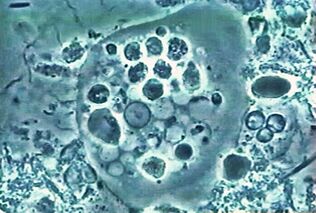
The first one. Oral amoebaEntamoeba gingivalis
The first parasitic amoeba found in humans. The amoeba description was published in 1849 in the oldest scientific journal. Amoeba is found in the dental plaque, hence the name of the Latin gum - gums.
Livesin the mouth of almost everyone with sore teeth or sore gums, inhabits gum bags and plaque. It feeds on epithelial cells, leukocytes, microbes and, in the case of erythrocytes. It is rare in people with a healthy oral cavity.
This small protozoan, 10–35 µm in size, does not leave the environment and does not form cysts, it is transmitted to another host through kisses, dirty dishes or contaminated food.E. gingivalisis considered an exclusively human parasite, but is sometimes found in cats, dogs, horses and monkeys in captivity.
In the early 20th century,E. gingivaliswas described as the causative agent of periodontal disease, as it is always present in inflamed dental cells. However, its pathogenicity has not been proven.
The drugsthat affect this amoeba are unknown.

The most comprehensive. Amoeba dysenteryEntamoeba histolytica
This bloody intestinal parasite penetrates the tissues of the liver, lungs, kidneys, brain, heart, spleen, genitals. Eat what you will receive: food particles, bacteria, red blood cells, leukocytes and epithelial cells.
Distributedeverywhere, especially in the tropics. Usually, people are infected by swallowing a cyst.
In temperate countries, the amoeba tends to remain in the intestinal lumen and the infection is asymptomatic. In the tropics and subtropics, the pathological process usually begins:E. histolyticaattacks the walls. The reasons for the transition to the pathogenic form are not yet clear, but several molecular mechanisms of what is happening have already been described. So it is clear that amoebae secrete lysing substances, break up mucus and kill cells. Apparently, the amoeba can destroy the host cell in two ways: by triggering apoptosis in it or simply by chewing pieces. The first method was considered the only one for a long time. In fact, the cellular suicide mechanism with record speed - in minutes - has not been identified. The second method was recently described, the authors called it trogocytosis from the Greek "three" - gnaw. It is noteworthy that cell-biting amoebae abandon their prey as soon as it dies. Others can phagocytize dead cells entirely. It is assumed that the cells that bite and devour differ in the expression pattern of the gene.
Now, the amoeba's ability to penetrate the bloodstream, liver and other organs is associated with troocytosis.
Amoebiasis is a deadly disease, about 100, 000 people die from infection withE. histolyticaevery year.
The amoeba dysentery has a non-pathogenic twin,E. dispar, so microscopy is not enough to diagnose the disease.
To healmust be destroyed as a mobileE. histolyticaand cysts.
DescribedE. histolyticaand determined its pathogenic nature in 1875 in a patient with diarrhea. The Latin name for amoeba was given in 1903 by the German zoologist Fritz Schaudin.Histolyticameans tissue destroyer. In 1906, the scientist died of an amoebic intestinal abscess.

The most common. Intestinal lambliaGiardia lamblia (G. intestinalis)
Giardia, the most common intestinal parasite, is ubiquitous. 3-7% of people in developed countries are infected and 20-30% in developing countries. That is about 300 million people.
The parasites livein the host's duodenum and bile ducts, where they float, working with the flagella, then attach to the epithelium with the help of a sticky disc located at the bottom of the cell. In 1 cm2the epithelium adheres to one million lamblia. They damage the villi, which interferes with the absorption of nutrients, causing inflammation of the mucosa and diarrhea. If the disease affects the bile ducts, it will be accompanied by jaundice.
Giardiasis is a disease caused by dirty hands, water and food. The life cycle of a protozoan is simple: in the intestine there is an active form, and at the exit with fecal masses, stable cysts. To get infected, just swallow a dozen cysts, which in the intestines will again become an active form.
The main secretof lamblia's ubiquity in the variability of surface proteins. The human body fights lamblia with antibodies and, in principle, is able to develop immunity. But people who live in the same area and drink the same water are continually infected by the descendants of their own parasites. Because? Because during the transition from the active phase to the cyst and vice versa, lamblia changes the proteins to which antibodies are made - variant-specific surface proteins. There are about 190 variants of these proteins in the genome, but only one is always present on the surface of an individual parasite, the translation of the others is interrupted by the RNA interference mechanism. And the change happens once every ten generations.
It is treatedwith an antiprotozoal agent with antibacterial activity. The disease disappears in a week, but if the bile ducts are infected, relapses are possible for many years. Cysts are fought by water iodination.
DiscoveryGiardia lambliain 1859 by Czech scientist Vilém Lambl. Since then, the simplest has changed several names and the current one received in honor of the French discoverer and parasitologist Alfred Giar, who did not describe lamblia.
And the first sketch of Giardia was made by Anthony van Leeuwenhoek, who found him in his overturned chair. It was in 1681.
By the way, Giardia is also very old evolutionarily, it comes almost directly from the ancestor of all eukaryotes.
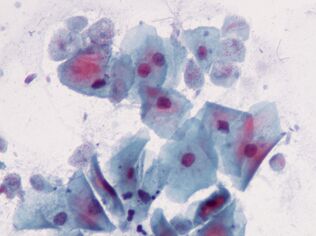
The most intimate. Trichomonas vaginalisTrichomonas vaginalis.
The simplest, which is sexually transmitted. It lives in the vagina and in men - in the urethra, in the epididymis and in the prostate, it is transmitted sexually or through wet towels. Babies can be infected by passing through the birth canal.T. vaginalishas 4 flagella at the anterior end and a relatively short undulating membrane; if necessary, it releases pseudopods. The maximum size of Trichomonas is 32 by 12 microns.
Trichomonas are morewidespreadthan the causative agents of chlamydia, gonorrhea and syphilis combined. It affects about 10% of women, and possibly more, and 1% of men. This latter value is not reliable because it is more difficult to detect the parasite in men.
T. vaginalisfeeds on microorganisms, including lactic acid bacteria from the vaginal microflora, which maintain an acidic environment and therefore creates an ideal pH for you above 4, 9.
Trichomonas destroys mucous cells, causing inflammation. About 15% of infected women complain of symptoms.
You are treatedwith an antibacterial medicine. As a preventive measure, regular use of hygienic showers with diluted vinegar is recommended.
Describedin 1836 by the French bacteriologist Alfred Donne. The scientist did not understand that there was a pathogenic parasite in front of him, but determined the size, appearance and type of movement of the simplest.
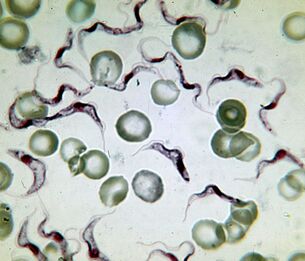
The most deadly. The causative agent of sleeping sicknessTrypanosoma brucei
The causative agent of African sleeping sickness is the most deadly protozoan. An infected person dies without treatment. Trypanosoma is an elongated flagellate 15-40 µm long. There are two subspecies that are indistinguishable externally. Illness caused byT. brucei gambiense, lasts 2 to 4 years.T. brucei rhodesienseis a more virulent transient pathogen that dies after a few months or weeks.
Distributedin Africa, among the 15 parallels in the southern and northern hemispheres, in the carrier's natural range - blood sucking insects of the genusGlossina(tsetse fly). Of the 31 species of flies, 11 are dangerous to humans. Sleeping sickness affects the population of 37 countries in southern Sahara, 9 million km2. Up to 20, 000 people get sick every year. Today, there are about 500 thousand patients, 60 million of whom are at risk.
From the intestine of the flyT. bruceienters the human bloodstream, from there it enters the cerebrospinal fluid and affects the nervous system. The disease begins with fever and inflammation of the lymphatic glands, followed by apathy, drowsiness, muscle paralysis, weakness and irreversible coma.
The lethality of the parasite is associated with its ability to cross the blood-brain barrier. The molecular mechanisms are not fully understood, but it is known that, upon entering the brain, the parasite secretes cysteine proteases and also uses some host proteins. In the central nervous system, on the other hand, the trypanosome is protected from immunological factors.
The first description of sleeping sickness in the upper regions of Niger was made by the Arab scholar Ibn Khaldun (1332-1406). At the beginning of the 19th century, Europeans were already well aware of the initial sign of the disease - the swelling of lymph nodes on the back of the neck (Winterbottom's symptom), and slave traders paid special attention to it.
It was discoveredT. bruceiScottish microbiologist David Bruce, who gave his name, and in 1903 he first established the connection between trypanosome, tsetse fly andsleeping sickness.
Treatmentdepends on the stage of the disease and the medications cause serious side effects. The parasite has a high antigenic variability, so it is impossible to create a vaccine.
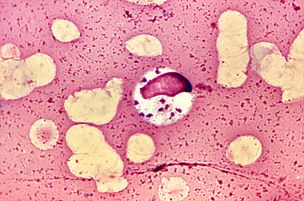
The most extravagant. LeishmaniaLeishmania donovani
Leishmanias won the title of the most extravagant parasites, because they live and reproduce in macrophages - cells designed to destroy parasites.L. donovaniis the most dangerous of them. It causes visceral leishmaniasis, colloquially dumdum fever or kala azar, from which almost all patients die without treatment. But survivors acquire long-term immunity.
There are three subspecies of the parasite.L. donovani infantum(Mediterranean and Central Asia) mainly affects children; dogs are usually your reservoir.L. donovani donovani(India and Bangladesh) is dangerous for adults and the elderly, it has no natural reservoirs. The AmericanL. donovani chagasi(Central and South America) can live in the blood of dogs.
L. donovani- flagellate not more than 6 microns in length. People are infected after being bitten by mosquitoes of thePhlebotomusgenus, sometimes through sexual contact, babies - passing through the birth canal. Once in the blood,L. donovanipenetrates the macrophages, which transport the parasite through the internal organs. Reproducing in macrophages, the parasite destroys them. The molecular mechanism of survival in macrophages is quite complex.
Symptoms of the disease- fever, enlarged liver and spleen, anemia and leukopenia, which contribute to secondary bacterial infection. Every year, 500, 000 people fall ill with visceral leishmaniasis and about 40, 000 die.
Heavy treatment- intravenous administration of antimony drugs and blood transfusion.
Taxonomic affiliationL. donovaniwas determined in 1903 by the famous malaria researcher and Nobel Prize winner Ronald Ross. It owes its generic name to William Leishman, and the specific name to Charles Donovan, who in the same 1903 independently discovered protozoan cells in the spleen of patients who died from kala azar, one in London and the other in Madras.
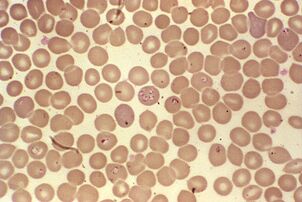
The most difficult life cycle. Babesia spp.
Babesias, in addition to asexual reproduction in various stages in erythrocytes of mammals and sexual mites in the intestines of the genusIxodes, complicated their development by transovarian transmission. From the intestines of a female mite, protozoan sporozoites penetrate the ovaries and infect embryos. When the mite larvae hatch, the babesia passes into the salivary glands and, with the first bite, enters the vertebrate's blood.
DistributedBabesia in America, Europe and Asia. Its natural reservoir are rodents, dogs and cattle. A person is infected with several types: B. microti, B. divergens, B. duncaniandB. venatorum.
The symptoms of babesiosis are similar to those of malaria - recurrent fever, hemolytic anemia, enlarged spleen and liver. Most people recover spontaneously. For patients with weakened immune systems, babesiosis is fatal.
Treatment methodsare still under development, although antibiotics and, in severe cases, blood transfusions are prescribed.
DescribedBabesia by the Romanian microbiologist Victor Babes (1888), who discovered it in sick cows and sheep. He decided he was dealing with a pathogenic bacterium that he calledHaematococcus bovis. Babesia was considered an animal pathogen until it was discovered in 1957 in a Yugoslavian shepherd who died of infection with B. divergens.
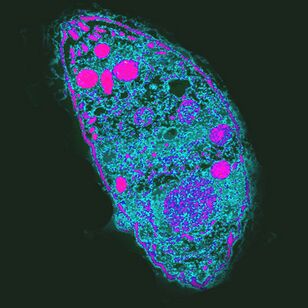
The most influential. The causative agent of toxoplasmosisToxoplasma gondii
T. gondiiis the most powerful parasite, as it controls the behavior of intermediate hosts.
Distributedeverywhere, unevenly distributed. In France, for example, 84% of the population is infected, in the United Kingdom - 22%.
The Toxoplasma life cycle consists of two phases: asexual occurs in the body of any warm-blooded person, sexual reproduction is only possible in the epithelial cells of the cat's intestine. ForT. gondiican complete development, the cat must eat an infected rodent. By increasing the likelihood of this event,T. gondiiblocks the rodents' natural fear of the smell of cat urine and makes it attractive, targeting a group of neurons in the amygdala. How she does it is unknown. One of the proposed mechanisms of action is a local immune response to infection. It alters cytokine levels, which in turn increases levels of neuromodulators such as dopamine. Toxoplasma also affects human behavior, which manifests itself even at the population level. Thus, in countries with a high rate of toxoplasmosis, neuroticism and a desire to avoid uncertainty, new situations are more common. It is possible that infection byT. gondiicould lead to cultural changes.
Infectionin humans is often asymptomatic, but with weakened immunity, it destroys cells in the liver, lungs, brain, retina, causing acute or chronic toxoplasmosis. The course of the infection depends on the virulence of the strain, the state of the host's immune system and its age - older people are less susceptible toT. gondii.
Treat toxoplasmosis with antiprotozoal drugs.
Describedin 1908 in desert rodents. This tribute belongs to the employees of the Pasteur Institute of Tunisia, Charles Nicolas and Luis Manso.
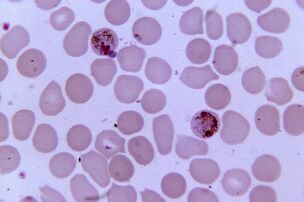
More pathogenic. Plasmodium malariaPlasmodium spp.
Plasmodium malaria is the most pathogenic parasite in humans. The number of patients with malaria can reach 300-500 million, and the mortality rate during epidemics - 2 million. The disease still claimed three times as many lives as armed conflicts.
Five types of Plasmodium cause malaria in humans:Plasmodium vivax, P. falciparum, P. malariae, P. ovaleandP. knowlesi, which also affects monkeys.
Distributedin the range of vectors -Anophelesmosquitoes, which need a temperature of 16–34 ° C and a relative humidity of more than 60%.
The comparison of the genome of the most virulent plasmodium,P. falciparum, with the gorilla plasmodium suggests that humans were infected by their ancestor by these monkeys. The emergence of this form of Plasmodium is associated with the emergence of agriculture in Africa, which has led to an increase in population density and the development of irrigation systems.
The sexual reproduction of plasmodium occurs in the intestines of mosquitoes and, in the human body, it is an intracellular parasite that lives and reproduces in hepatocytes and erythrocytes until the cells rupture. 1 ml of the patient's blood contains 1 - 50 thousand parasites.
The disease manifests itself as inflammation, periodic fever and anemia, in case of pregnancy it is dangerous for the mother and the fetus. Red blood cells infected withP. falciparumobstruct capillaries and, in severe cases, ischemia of internal organs and tissues.
Treatmentrequires a combination of several drugs and depends on the specific pathogen. Plasmodiums become resistant to drugs.






































